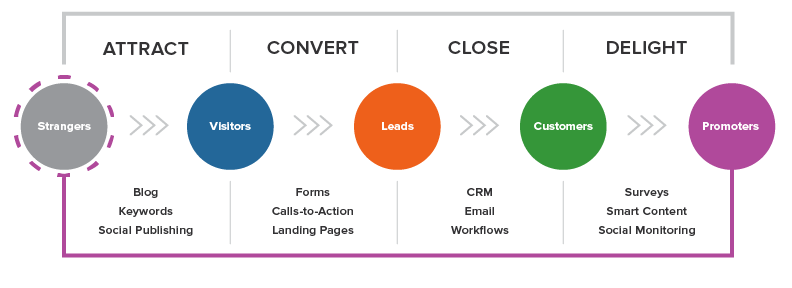Strategies for Each Stage of the Inbound Marketing Funnel
What you’ll learn about making the most of each stage of the inbound marketing funnel:
- Inbound marketing is a collection of marketing activities designed to bring visitors in
- The inbound marketing funnel is made up of four parts
- Attract
- Convert
- Close
- Delight
- There are specific marketing strategies that align with each stage
At Umami Marketing, we’re passionate about inbound marketing. We love the idea of helping companies earn the attention of their target audiences, putting the focus on valuable and timely content that carries customers through the path to purchase.
A big part of how we think about this process is in the framework of the inbound marketing funnel, pictured below.

In our early conversations with our clients, we often find that while they know about the funnel, they don’t necessarily have strategies aligned with each stage. With that in mind, this post addresses the best strategies for each stage of the inbound marketing funnel so that you can keep your prospects engaged every step of the way.
Finding Success in the Inbound Marketing Funnel
At each stage of the inbound marketing funnel, there are a number of things you can do to keep your prospects engaged and moving forward to the next step. Here are some suggestions.
Attract
As the name implies, the first stage of the inbound marketing funnel is dedicated to attracting your target audience and making them interested in your brand. The content you produce should be educational and representative of how your offerings can solve specific problems.
To start, make sure you have clearly defined buyer personas. They will be key for providing strategic direction—everything you do should ladder up to their needs and wants. Then, create content that provides value to these personas. Write educational posts about your industry or the common challenges your target audience faces, create engaging and shareable content on social media, build easy-to-follow guides that demystify your product, and rally your existing customers to share relatable testimonials. Collectively, this content will create an appealing image of what your brand can offer and why your prospects may want to choose you.
Another important strategy here is search engine optimization (SEO) as it will help your content rank for the topics that your target audience is searching for. Identify the keywords and phrases that are most relevant to your products and services, as well as the challenges you’re trying to solve for customers. Pair this strategy with great, informative writing, and you’ll make a strong first impression.
Convert
Once you’ve attracted people to your website with high-ranking blog posts, the next step is to turn them into qualified leads for your sales team. This requires getting them to share contact information in exchange for a demo, webinar, or gated content. Whatever you choose to engage your prospects with, it should be information that’s intrinsically valuable to them—in a more detailed way than the content you use at the awareness stage.
To set up your conversion-focused content, you can build appealing landing pages that provide a gist of what the content is about and how it can help the reader. Landing pages are also a great place to host your sign up forms, which should be carefully crafted to not put people off from sharing their information. You need to find the balance between asking for enough information to fuel your marketing and sales efforts, without making it feel like you’re invading someone’s privacy.
Close
While it’ll be on your sales team to close the purchase, your team will also play a role at this stage. More and more, marketing and sales are collaborating to bring in better quality leads and build a more efficient path to purchase. For instance, you can build a nurture email flow with timely whitepapers or webinars that go deeper into how your product solves for specific pain points. You can also keep your sales team aware of any events you’re hosting as these will give them an opportunity to invite leads and have an in-person conversation in a conducive context.
Delight
Once a prospect becomes a customer, there’s still a lot of work to be done to keep them engaged, happy, and supported. This is a crucial step in the process: delighted customers are much more likely to become brand advocates and promote your products and services to their peers. So, how do you get it right?
To start, you need to ensure that your customers have multiple avenues to provide feedback or ask for help. A timely feedback survey or community forum can be a great way to keep your customers engaged and willing to share actionable insights. Meanwhile, a chatbot that is designed to support customers with a new feature shows that you’re thinking about how they engage with your product. You can also partner with your customer success team to provide this avenue by sharing valuable case studies.
Now, if you’re going to send a survey or chatbot, share them at relevant points in the customer’s journey to make sure they add the most possible value to the customer experience. A smart marketing automation tool can help you identify the right time to reach out to a customer based on how they’ve engaged with your product.
Social media engagement is another helpful strategy. Today, your customers are likely to tag your social media profile when they’re experiencing an issue with your products—and want to tell the world about it. Respond to these posts with helpful information that points them in the direction of a solution. You won’t just be taking a step towards winning over a single detractor; other prospects and customers that see your response will appreciate your approach.
As you build your inbound marketing strategy, it’s important to focus on each of these stages and ensure that you’re delivering the same level of value across the funnel. This will not only help you engage the right customers, but it will also keep your existing customers coming back and supporting you as you grow your business and offerings.
If you’d like help building that strategy, get in touch. We’ve built over a decade of expertise in inbound marketing, and we’re always excited to help new brands find their footing in this space.
Photo by Sam


